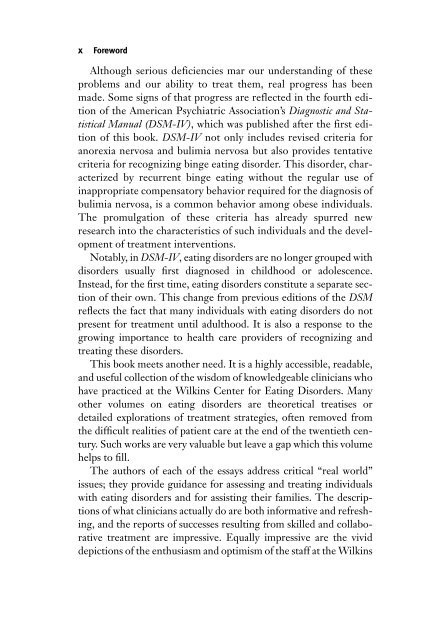Eating Disorders - fieldi
Eating Disorders - fieldi
Eating Disorders - fieldi
You also want an ePaper? Increase the reach of your titles
YUMPU automatically turns print PDFs into web optimized ePapers that Google loves.
x Foreword<br />
Although serious deficiencies mar our understanding of these<br />
problems and our ability to treat them, real progress has been<br />
made. Some signs of that progress are reflected in the fourth edition<br />
of the American Psychiatric Association’s Diagnostic and Statistical<br />
Manual (DSM-IV), which was published after the first edition<br />
of this book. DSM-IV not only includes revised criteria for<br />
anorexia nervosa and bulimia nervosa but also provides tentative<br />
criteria for recognizing binge eating disorder. This disorder, characterized<br />
by recurrent binge eating without the regular use of<br />
inappropriate compensatory behavior required for the diagnosis of<br />
bulimia nervosa, is a common behavior among obese individuals.<br />
The promulgation of these criteria has already spurred new<br />
research into the characteristics of such individuals and the development<br />
of treatment interventions.<br />
Notably, in DSM-IV, eating disorders are no longer grouped with<br />
disorders usually first diagnosed in childhood or adolescence.<br />
Instead, for the first time, eating disorders constitute a separate section<br />
of their own. This change from previous editions of the DSM<br />
reflects the fact that many individuals with eating disorders do not<br />
present for treatment until adulthood. It is also a response to the<br />
growing importance to health care providers of recognizing and<br />
treating these disorders.<br />
This book meets another need. It is a highly accessible, readable,<br />
and useful collection of the wisdom of knowledgeable clinicians who<br />
have practiced at the Wilkins Center for <strong>Eating</strong> <strong>Disorders</strong>. Many<br />
other volumes on eating disorders are theoretical treatises or<br />
detailed explorations of treatment strategies, often removed from<br />
the difficult realities of patient care at the end of the twentieth century.<br />
Such works are very valuable but leave a gap which this volume<br />
helps to fill.<br />
The authors of each of the essays address critical “real world”<br />
issues; they provide guidance for assessing and treating individuals<br />
with eating disorders and for assisting their families. The descriptions<br />
of what clinicians actually do are both informative and refreshing,<br />
and the reports of successes resulting from skilled and collaborative<br />
treatment are impressive. Equally impressive are the vivid<br />
depictions of the enthusiasm and optimism of the staff at the Wilkins









